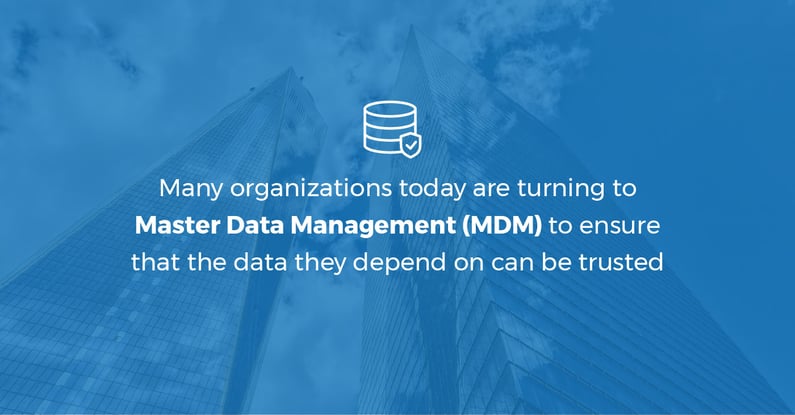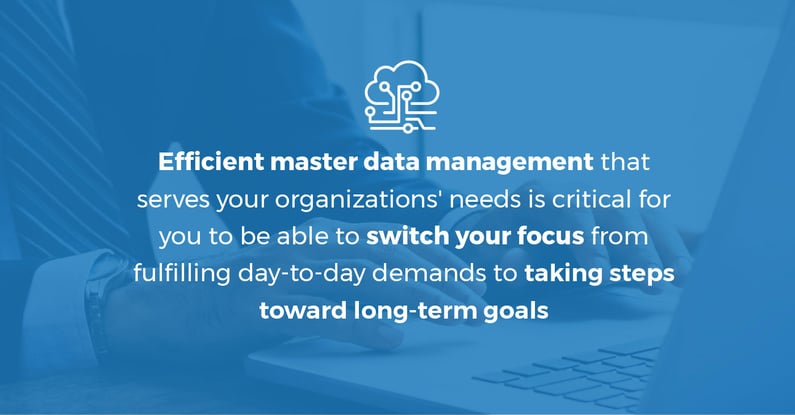Corporations today are generating and retaining huge amounts of data. When handled correctly, that data can be a treasure trove of vital information that can be mined for insights that can drive a business forward.
But that only applies if the data is of good quality. When companies put their trust in information they glean from faulty, low-quality data, they can make decisions that cause immense, even survival-threatening problems. That's why many organizations today are turning to Master Data Management (MDM) to ensure that the data they depend on can be trusted.

What is Master Data Management?
In its glossary of technical terms, Gartner provides a formal definition of MDM:
Master data management (MDM) is a technology-enabled discipline in which business and IT work together to ensure the uniformity, accuracy, stewardship, semantic consistency and accountability of the enterprise's official shared master data assets. Master data is the consistent and uniform set of identifiers and extended attributes that describes the core entities of the enterprise including customers, prospects, citizens, suppliers, sites, hierarchies, and chart of accounts.
But what does that mean in practice?
A company's data can be compromised in several ways. First, of course, what was entered into the system might simply be factually inaccurate (wrong information or perhaps a typo). But beyond that, the data can be outdated, incomplete, or inconsistent (non-identical versions of the same data element exist at different places in the system).
The purpose of MDM is to maintain a set of accurate, up-to-date master records that can be referenced as the "single source of truth" for each significant person, place or thing that the business references in its day-to-day operations.
Why is MDM important?
MDM aims at ensuring that the organization has the same accurate information across all its locations and networks, no matter where the data is entered or accessed. For example, if a customer's address was originally entered at a branch office but is changed online, MDM ensures that the address change is reflected back to a single master record that's guaranteed to have the latest information. So, when a worker at the branch asks the system for the customer's address, what the system delivers will be the address stored in the master record rather than the one originally entered at that branch.
To take another example, if the branch enters a record for Robert Smith, but there's an online transaction involving Bob Smith, is this the same person or two different ones? A good MDM system will have processes for verifying whether Robert and Bob are the same person, and if they are, ensuring that both variants of the name are reflected in the master record.
How MDM works
To ensure that master records are always accurate and up-to-date, MDM systems use the following processes:
- Data Cleansing — Records that are inaccurate due to issues such as errors in data entry, punctuation, or spelling, are identified and either corrected or removed. (By the way, the term "data cleansing" is often applied to the entire process of analyzing and correcting data records to ensure their accuracy, completeness, and consistency.)
- Data Validation — Ensures that records are accurate and complete (for required values, none are blank, null, duplicated, incorrect, or out-of-range).
- Data Linking — Information from corresponding records in different locations is intelligently combined into a single master record.
- Data Enrichment — Information from external sources, such as demographic or geolocation data, is added to the master record for a particular data element.
- Data Deduplication — Inconsistencies are eliminated by ensuring that different instances of the same data are intelligently reconciled into the master record, and all duplicate records are removed.
Common problems with implementing MDM
The ultimate challenge of MDM is the necessity of reconciling data that may have been entered through different systems (even by different organizations) and in different formats to create a single master record that's accurate, complete, and kept current in near real time. Implementing an MDM system that can reliably handle that level of complexity is a challenge.
For example, the records used by Sales and by Finance to refer to the same customer may be completely different in format and information content. Yet the MDM system must not only be able to identify that records from each source refer to the same individual, but to also reconcile and appropriately merge information that was entered using different standards (Jim Smith vs. Smith, James R., for example).
In setting up the MDM system, it's possible for mistakes to be made by the person, or perhaps the AI (artificial intelligence) agent, tasked with defining and implementing protocols for handling complex issues of data identification, standardization, and reconciliation. And when that kind of error is incorporated into an MDM platform, a company's entire data storage and retrieval system can become unreliable.
For this reason, issues such as the following must be effectively addressed before the MDM system can be put into operation:
- Who owns the data? Who defines the policies and business rules governing how data is managed?
- How do you define format and content standards for the master data records so that they are compatible with all the data types and formats used in your organization?
- How do you synchronize data across multiple systems?
- Who has access and authorization to edit data?
- Who accepts changes?
Implementing MDM
Efficient master data management that serves your organizations' needs is critical for you to be able to switch your focus from fulfilling day-to-day demands to taking steps toward long-term goals. eSystems can help make MDM a reality in your organization using our simple five-step process:
- Identify data sources—Identify the data sources that will feed into the MDM system, along with the data formats used by each.
- Curate data—Organize, annotate, and manage your source datasets to make them compatible with your master record setup.
- Apply workflow—Monitor how data pipelines and data jobs run and, if they fail, notify appropriate parties.
- Drive data harmonization across the organization and two-way synchronization across multiple systems—Start the process of enabling departments to perform analytics on the curated corporate data assets.
- Enable reporting—Enable decision-making in relation to specific requirements and regulations. Apply impact analysis to help identify data outliers and minimize data quality problems in the downstream data pipeline processes.
The great thing is that you don't have to start from scratch or go it alone in your MDM journey. The eSystems low-code MDM solution will provide all you need every step of the way, from initial development to updates far in the future.
Get your data to serve YOU, not vice versa. Get started today with eSystems. Just contact us.

WRITTEN BY: Mika Roivainen | Chief Digitalization Officer




COMMENTS